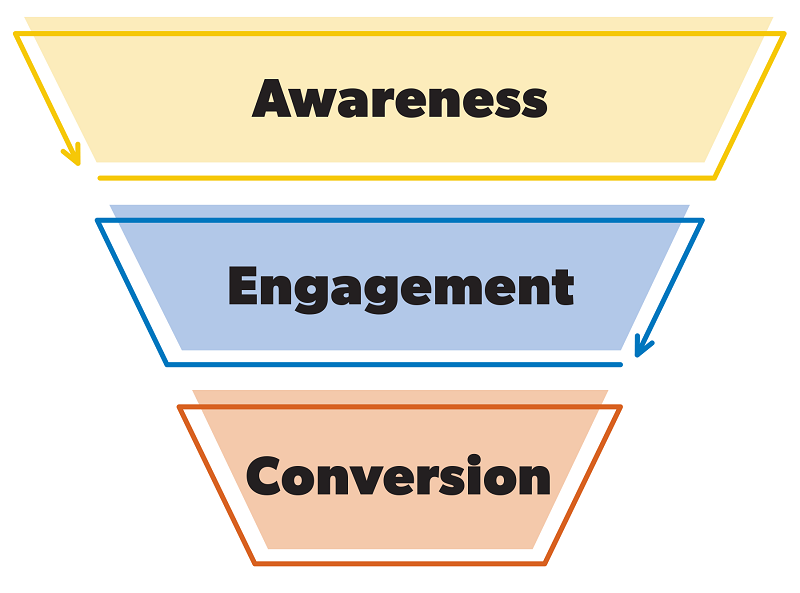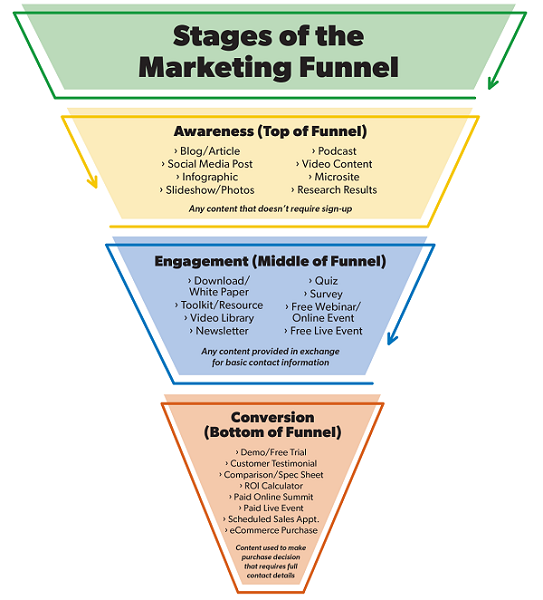The concept of a sales funnel has been around for decades in the sense that companies try to find large numbers of prospects (the top of the funnel), nurture those prospects over time to increase engagement (the middle of the funnel) and then work to close sales (the small bottom of the funnel). AV integrators can learn a lot from understanding every step in this system.
This idea has been co-opted by digital marketers to mean a specific online experience that brings a prospect through the entire buying process to the point of purchase.
The idea is to take the prospect by the hand and digitally walk them through the stages of awareness of your brand, engagement with your content and ultimately making a purchase (conversion).
The diagram below illustrates these three phases of the marketing funnel:
When putting together your marketing plan, it can seem haphazard to determine when and why to use social media posts, host a webinar or develop a digital tool like an ROI calculator.
In fact, there is a method to this madness. Specific marketing vehicles should be used for each stage of the marketing funnel.
The top of the funnel (TOFU) is when you want to introduce a new contact to your brand. Key marketing techniques at this stage are blogs, social media posts, infographics, podcasts, videos, etc.
You will notice that all these marketing vehicles focus on communicating information – not selling. You will be “giving” away content and not asking for so much as an email address in exchange. You would use a lot of organic social, paid social, banner ads, SEO, etc. to bring people into the top of funnel.
The middle of the funnel (MOFU) is the period when you are slowly nurturing a new prospect to pique their interest and make them feel engaged with your brand. Specific marketing strategies used at this stage include educational downloads, toolkits, newsletters, quizzes, surveys, and webinars.
The commonality at this stage is that you will be asking for some contact information to help build your database so you can then continue to reach out to these people. Since you may not yet have the prospects’ contact info, you would rely heavily on organic social, paid social and search engine marketing to promote these programs.
The bottom of funnel (BOFU) is where things really get exciting. You use promotions like free trials, discounts, live events, spec sheets, etc. to encourage prospects to schedule a sales call or make an online purchase.
At this point, you do have contact information so you will rely heavily on email, re-targeting and telemarketing to move prospects towards a sale.
There are so many options for getting your marketing message out that it can seem confusing and sometimes overwhelming. A good place to start is to envision a simple path through the marketing funnel:
1. Develop a Single Top of Funnel Piece of Content
This could be a blog post addressing a problem that your customers commonly face. Maybe they don’t understand how to choose the right projector to meet their needs. You could write a brief overview of the important considerations.
You would then need a plan for how to get people to this blog post with a focus on brand new contacts. No cost options include organic (unpaid) social media posts on LinkedIn, Facebook and Twitter.
You should also join relevant social media groups and after you have been engaged in the group for a while you can start to post helpful resources like this.
You can also assign some marketing budget to this effort with banner ads, Facebook ads, Google ads, etc. You can usually invest a small amount of budget when driving traffic to top of funnel content and still get measurable results.
2. Create One Download to Collect Leads
The next step is to expand upon the topic of your blog post and create a 3-5 page download that has enough helpful tips that prospects will feel it’s worth trading their contact info to get it.
In this longer format, you can include project examples and why certain projectors worked best in each situation. Or, expand upon your topic a bit and discuss videoconferencing rather than just projectors. You do want the content of the download to be related to the original post, though, so that the people you are driving to your blog post will be interested in your download.
Once your download is ready, you want to call it out within your blog post and on your website. You should also promote it through local and industry media, social media, third party emails, SEO, etc.
You will want to collect just a small amount of contact information with this download such as name, email and company so that you get as many leads as possible. These contacts should eventually feed into an email nurture sequence or marketing automation system.
3. Build a High-value Tool to Drive the Prospect to Purchase
As a result of all this nurturing, some of your prospects will now be ready to plan for a purchase. One great way to become an indispensable partner in the buying process is to offer a tool like an ROI calculator.
It can either be a sophisticated digital tool on your website or simply a spreadsheet that you have built out. The key is that it must help prospects make their purchase decision.
You should require more details in order for prospects to download this tool such as the type of project they are planning and their implementation timeline.
Ideally, you will also embed an online scheduler into the thank you page after they download this tool so your prospects can immediately schedule a time to speak with a sales rep.
At this point, you have well nurtured prospects who are very interested in your offerings. It’s time to turn this marketing qualified lead (MQL) over to the sales team. This is where the hand-off process of MQLs to the sales organization is critical.
Someone who has downloaded a spec sheet that compares your offerings with your competitors is a pretty hot lead, especially if you have a customer relationship management (CRM) system that can track that they have interacted with your content five times in the past month.
Your sales team needs to reach out to these leads in the next 24 to 48 hours – not two weeks from now. It’s critical that you have a defined process for who will hand off the leads to whom, how they will do it, when it will happen and how the results will be tracked.
Understanding the strategy of the marketing funnel will help you better plan your marketing initiatives and get the most bang out of every dollar spent. A well-planned funnel becomes a growth engine that feeds your sales team with the hot leads they need to consistently grow revenue









